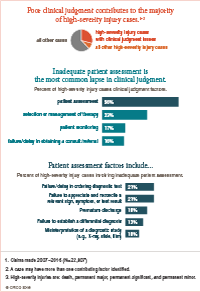Newsletter
The Risk of an Incomplete Patient Assessment
Apr 26, 2018
Inadequate patient assessment is a contributing factor in more than half of all medical malpractice cases.
Per CRICO’s national Comparative Benchmarking System (CBS), the top category of factors that contribute to allegations of medical malpractice is clinical judgment: for cases involving a high-severity injury (including death), 77% involve at least one clinical judgment issue. When we look at the total incurred losses for those cases, 88% of financial reserves (open cases) and indemnity payments (closed cases) is associated with clinical judgment factors.
“Clinical judgment” encompasses a broad array of decision making and actions, from making rushed treatment decisions to taking too long to order a test or referral. Thus, judgment issues are found across all specialties and settings, and they sidetrack clinicians at all levels of practice.
Drilling into the clinical judgment issues, we find that breakdowns in patient assessment (56% of high-severity cases) are most commonly noted. Eight of the top 20 contributing factors found in high-severity malpractice cases filed from 2007–2016 are related to patient assessment.
Because multiple contributing factors may be assigned, any single event may reflect multiple missteps in the patient assessment process (e.g., the lack of differential diagnosis might preclude the appreciation of relevant symptoms or test ordering). Of course, preventable adverse outcomes often reflect a constellation of missed opportunities, so other clinical judgments may be involved as well: specialty referrals, treatment regimens, and patient monitoring are commonly concurrent factors.
Obviously, analysis of malpractice data offers hindsight unavailable to clinicians assessing patients in real time: testing and referring every patient is not appropriate care. Clinicians with a consistent and comprehensive process—supported by effective systems—should be able to trust their judgment. At the same time, clinicians need to be aware of—and act upon— the cues that signal a discordance between their assessment and the patient’s experience:
- Revisit potential causes of recurring symptoms;
- Keep tabs on unresolved complaints (e.g., add them to the problem list);
- Recognize the need to reassess when test results don’t jibe with your expectations;
- Reconsider a proven treatment regimen that renders poor results;
- Investigate the underlying reasons for a patient’s prolonged recovery time following routine procedures.
- Treating these signals as a prompt to revisit the assessment process may help get the patient's care plan back on track and help you avoid an allegation of a missed diagnosis or inappropriate medical treatment.

 Click to open image.
Click to open image.